What is Evaluate Your Plate?
Evaluate Your Plate takes a critical look at the foods that comprise the bulk of our food system, including factory-farmed animal products. The tool is two-in-one: Map Your Meal enables users to compare the sustainability of popular meals, and Examine Your Eating allows them to quickly and easily assess their overall diets. In both cases, users get an eco-impact report card across six sustainability metrics, as well as suggested plant-forward recipes. The tool is designed to inspire individuals, companies, and policymakers to pursue food choices that are good for animals, people, and the planet.
Why did we create Evaluate Your Plate?
Evaluate Your Plate is built on the recognition that food is central to human health, environmental sustainability, and farmed animal welfare—and that our current choices are a threat to all three. As the global population swells to 10 billion by 2050, our planet will not be able to sustain the consumption patterns established by North America, Europe, and China.
Even as our food system produces more than ever before, we aren’t prioritizing the right foods—unhealthy diets now pose a greater risk to sickness and death than unsafe sex and the consumption of alcohol, drugs, and tobacco combined. Furthermore, most farmed animals—topping 70 billion on land and 40 billion in water—are reared on factory farms that prioritize profits over principles and are characterized by barren conditions, unnatural and caged environments, and designer breeding that fits animals to systems’ needs rather than vice versa.
From the climate crisis to environmental pollution, wildlife destruction to public health hazards, farm worker exploitation to social injustice, the consequences of our current food system extend well beyond the “farm.” Evaluate Your Plate is designed to shine light on the realities of our food system and inspire users to take action at mealtime.
How does Evaluate Your Plate approach food sustainability?
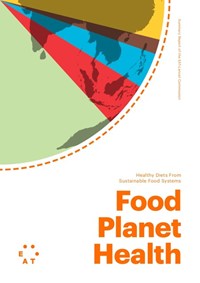
In 2019, a group of 37 leading nutritional, agricultural, environmental, and political scientists from 16 countries published the EAT-Lancet Commission, calling for a “Great Food Transformation” and establishing global scientific targets for healthy diets and sustainable food production. Their report asserted that “Strong evidence indicates that food production is among the largest drivers of global environmental change by contributing to climate change, biodiversity loss, freshwater use, interference with the global nitrogen and phosphorus cycles, and land-system change.”
Despite these challenges, there is a win-win opportunity for both people and planet: Increase consumption of healthy foods such as fruits, vegetables, legumes, and nuts; and reduce global consumption of less healthy foods, including animal products and sugar by at least 50 percent. Such a change could prevent approximately 11 million deaths per year (representing 19-24 percent of total adult deaths) while preventing irrevocable damage to the planet.
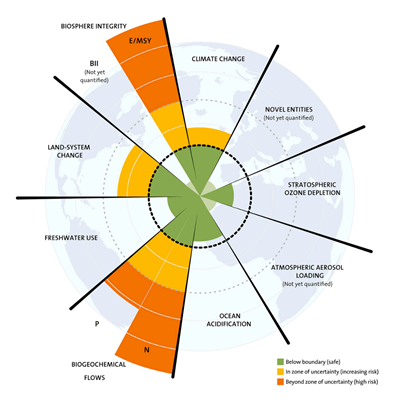
The potential for that damage is made clear by the Planetary Boundaries assessment (left), which quantitatively evaluates nine processes that regulate Earth’s stability and whether they land within a safe operating zone (green) or beyond (yellow and orange). Currently, we are functioning beyond the planetary boundary in four of the nine areas – all of which are flagged by the EAT-Lancet Commission. While reducing our global greenhouse gas emissions rightfully deserves significant attention and effort, the Planetary Boundaries assessment makes clear that we cannot have tunnel vision.
From the Chesapeake Bay to the Amazon Rainforest, news stories are emerging that reinforce the need to look at the far-reaching, multifold impacts of food production. For instance, nutrient pollution from concentrated chicken production on the US’ Delmarva peninsula is damaging the Chesapeake Bay; and chicken production in Europe is contributing to deforestation in Brazil, where chicken feed is grown.

We designed Evaluate Your Plate with the findings of the EAT-Lancet Commission in mind, harnessing their planetary boundaries framework to paint a full picture of sustainability—one that considers the wide-ranging intersectional impacts of food production.
How does Evaluate Your Plate work?
Evaluate Your Plate calculates impacts across six key areas – greenhouse gas emissions, nutrient pollution (eutrophying emissions), biodiversity loss, land use, stress-weighted water use, and animal impact. The tool also incorporates a “Planet Weight” score, which combines the five environmental metrics into a single, weighted metric that can be more easily compared between foods.
Our data uses a life cycle approach, which includes the materials, energy, and environmental impacts of a food’s full chain of production. In the case of food and other agricultural products, the assessment includes the environmental costs of manufacturing, transporting, and applying fertilizers to grow crops; extracting and refining diesel for tractors; the storage and disposal of animal manure; and transportation and processing of plants and animals after harvest or slaughter. This approach allows a full accounting of energy, land, and water use necessary to bring a particular food to point of sale. Across each metric, impacts were normalized per one kilogram of edible food at retail.
To take a closer look at the data underlying Evaluate Your Plate, explore the impacts of two popular proteins: chicken and peas. Chicken is often described as a healthier and more planet-friendly option, but when compared to peas, its impacts are still significantly greater across every impact area. Also noteworthy is how impacts vary between North America and Europe, primarily due to where chicken feed is grown.
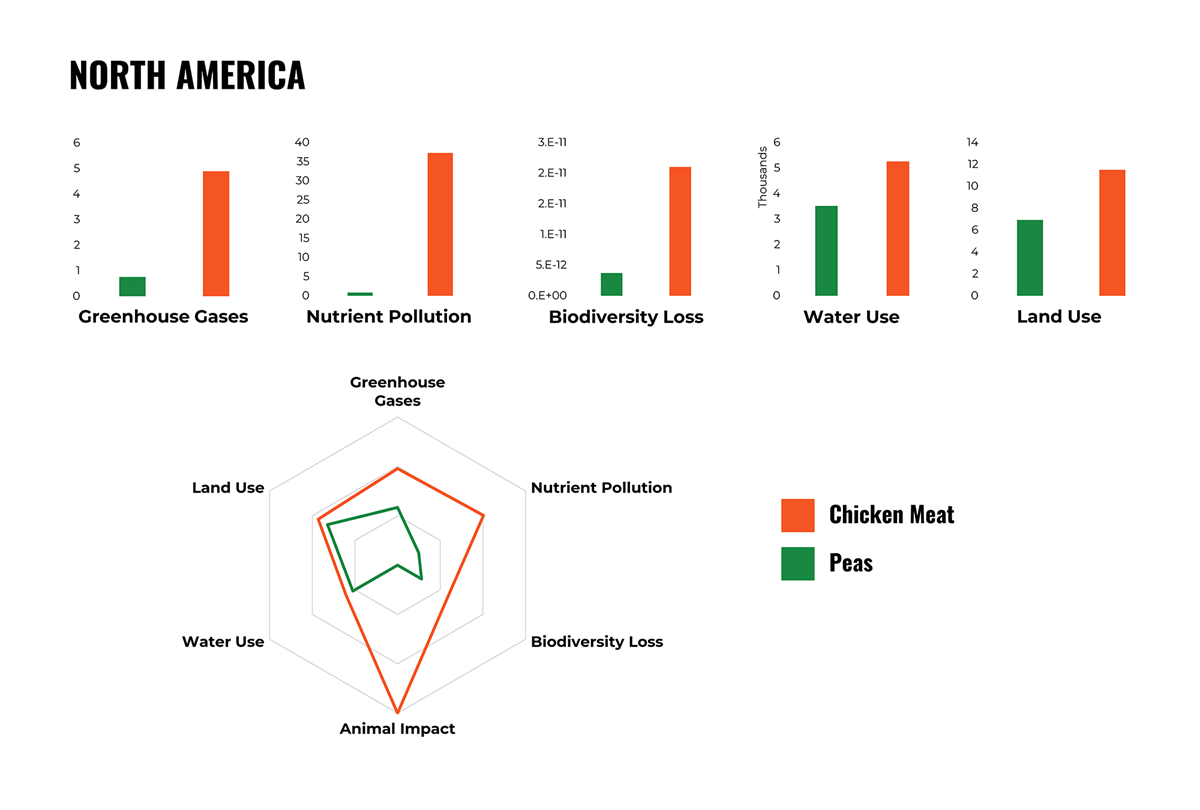
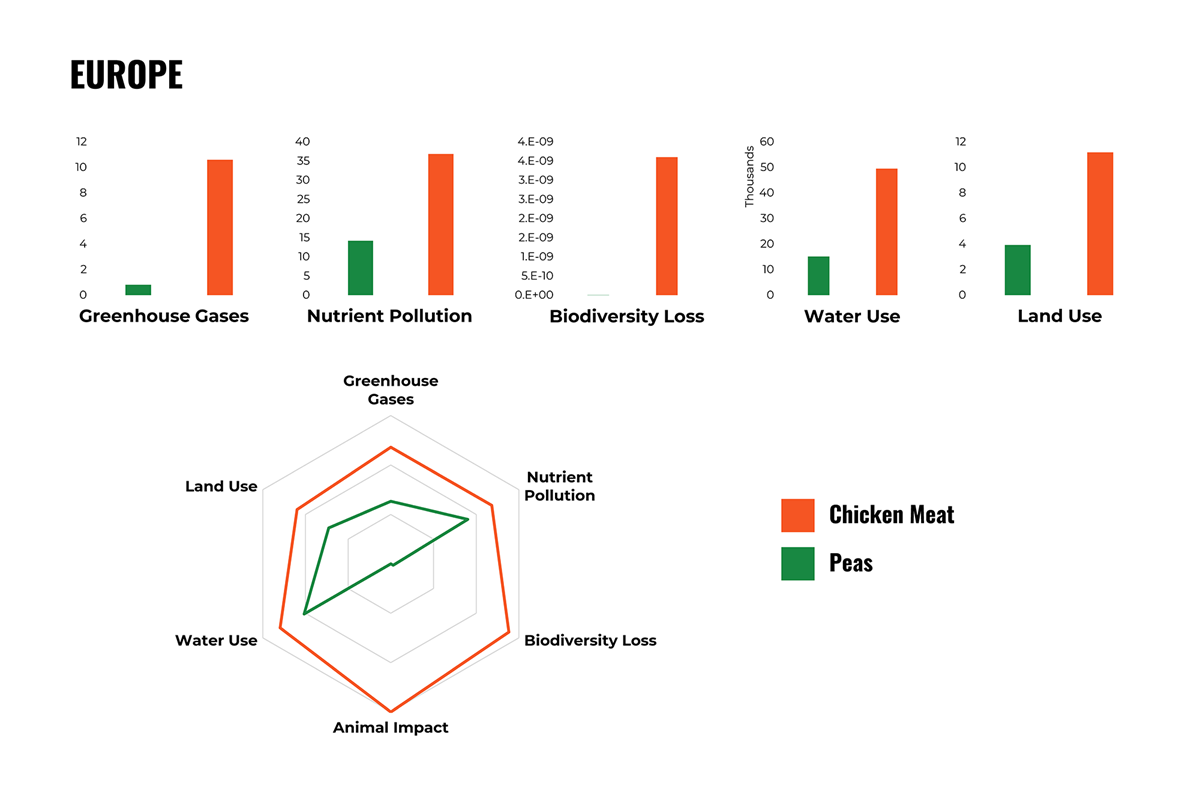
We developed a Planet Weight metric to to compare the overall impact of foods on planetary health (for more information on how the metric was developed, see the Methodology Overview). The graph below reflects Planet Weight scores across all foods researched in North America and Europe—though, notably, some of the luxury foods (e.g. coffee, wine) do not appear in Evaluate Your Plate. The takeaway from our Planet Weight data is clear: Animal products, both land and aquatic, have the biggest environmental footprints per edible kilogram.
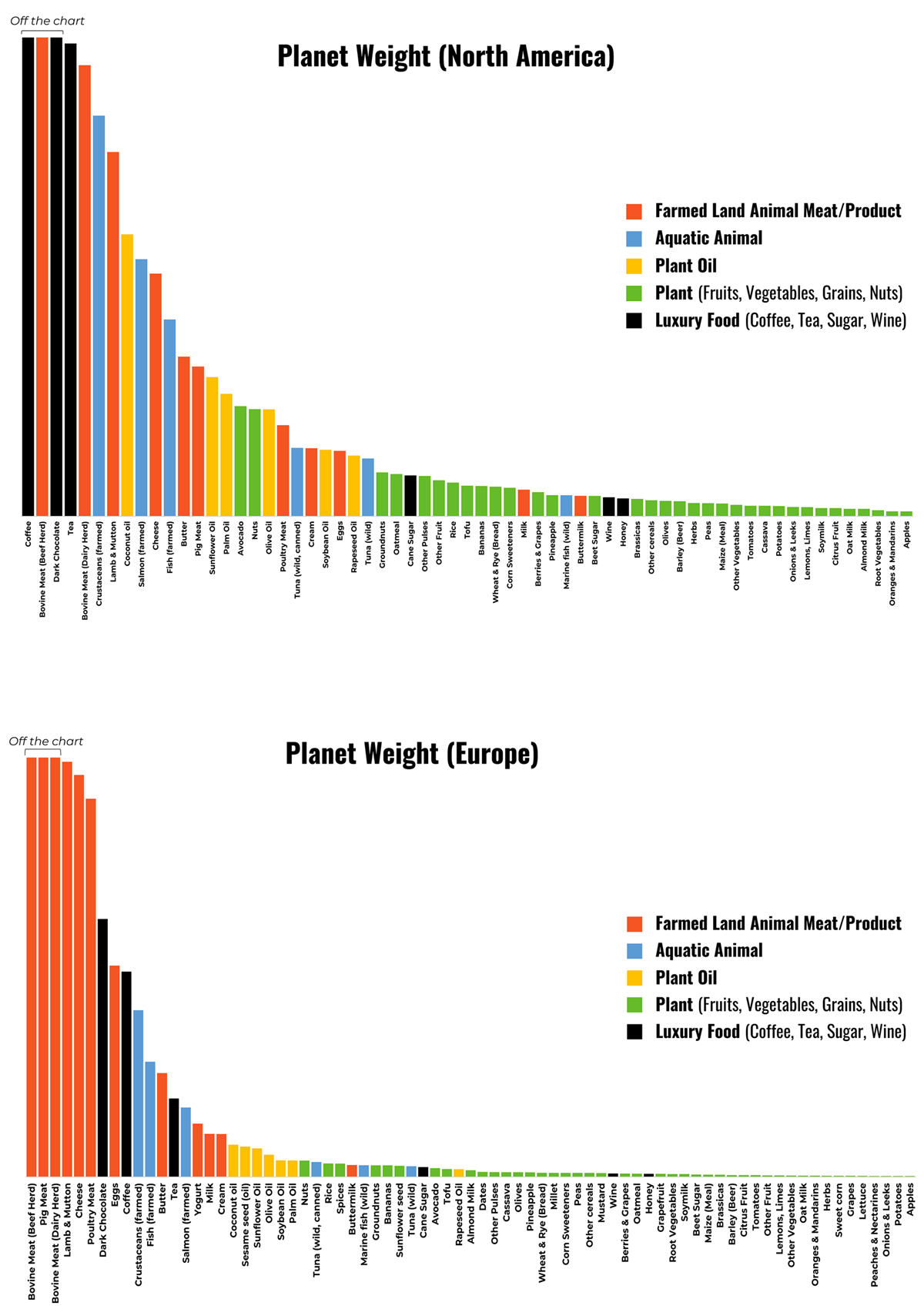
What is the methodology behind Evaluate Your Plate?
Working with Dr. Isaac Emery of Informed Sustainability Consulting (ISC), we developed a scientifically robust methodology to determine quantitative environmental impacts for common foods; the methodology to determine animal impact and establish grades was developed internally. Below is an overview of the data development process:
Data inventory: We estimated the environmental impacts of foods produced (or in some cases, consumed) in Europe and North America, including all phases of the food supply chain. Data was sourced from peer-reviewed scientific literature (such as Poore & Nemecek 2018)¹ and state-of-the-art industry databases. To guarantee fair comparison, we used one kilogram of edible food at retail as the functional unit across all foods. A sixth metric measuring food’s impact on animals was developed using agricultural data from the United States Department of Agriculture’s Economic Research Service, and the Food and Agriculture Organization of the United Nations. Animal impact measures the number of animal lives directly impacted by the creation of one edible kilogram of food.
Impact Metrics (per kg of edible food):
- Greenhouse Gases (kg CO2- equivalent emissions)
- Land Use (m2 per year)
- Water Use (stress-weighted water use AWARE methodology, L-equivalents)
- Nutrient Pollution (eutrophying emissions, g PO43- equivalent emissions)
- Biodiversity Loss (species × years)
- Animal Impact (liveweight or production rate)
Planet Weight Impact Assessment: For the overarching evaluation of foods (represented by letter grades in Map Your Meal and a “Yikes” to “Planet Hero” spectrum in Examine Your Eating), we compiled a weighted eco-impact score.
- Assessment: Using the best available life cycle assessment methods, we estimated the effects of producing each food ingredient on five key “planetary boundaries.” The five planetary boundaries examined are climate change, freshwater use, land-system change, biogeochemical (e.g. nitrogen and phosphorous) flows, and biodiversity loss.
- Normalization: Eco-impacts for each food ingredient were normalized to the estimated total impact of the global food system on each planetary boundary. For example, the climate change emissions of each food were divided by the estimated total climate change emissions for the entire global food system.
- Weighting: Normalized impacts for each food were weighted according to the severity of civilization's impacts on each planetary boundary. For example, climate change emissions from the global food system are about 2.6 times higher than they should be to maintain a stable climate, so normalized climate change impacts for each food were multiplied by 2.6.
- Meal and Diet Evaluation: Meal-based and diet-based assessments were developed by multiplying individual impact and Planet Weight metrics by gram amounts cited in a recipe or diet. Recipes were identified from publicly-available online sources, without predetermining environmental scores. Diet-based assessment was developed using the food categories recognized in the Planetary Health Diet and reflected Examine your Eating (for plant categories, impacts reflect calculated averages of foods in that category; for animal products, which are more explicitly referenced in the Planetary Health Diet, individual food metrics were used).
- Report Card Creation: Map Your Meal and Examine Your Eating plot the impact metrics for each of the six impact categories in radar charts depicting the full impact of a user’s meal selection or diet evaluation. These radar charts use a radial (circular) display with six different axes originating from the center. Each axis represents an impact category and is normalized to account for the range of data of each individual metric, making radar charts ideal for comparing a single meal or eating pattern’s impact across all six categories. We plotted the impact metrics along each axis to form a shape; the closer to the center a selection appears, the lower the impact; the further from the center, the larger the impact. While the actual numbers are not displayed on the radar charts, the relative difference between the shapes formed by different user inputs reflects which meals have higher impacts than others.
A Note About Plant-Based Meat
Evaluate Your Plate currently only evaluates whole foods, and thus does not include plant-based meats like those created by Beyond Meat and Impossible Foods. However, because their core ingredients are plant proteins (i.e., peas, soybeans, mung beans), life-cycle assessments show that their impacts are significantly lower than their meat-based counterparts.

Looking to the Future
Evaluate Your Plate illustrates the critical need to rebalance our food system to prioritize production and access to foods that are better for people, planet, and animals. Compassion believes that the time is now to realize that transformation, and is excited to work with individuals, companies, and policymakers to achieve it. But, given the scale of the challenges we face and the need to ensure that farmers and workers are supported in the transition, we’re calling on everyone to start taking steps forward—whether you’re making simple swaps at mealtime or working toward more sweeping marketplace changes.
As an individual, you can choose a better future every time you eat. Enjoy more fruits, vegetables, and plant proteins, and start cutting back on animal products and ensuring those you do eat come from higher-welfare systems (e.g. cage-free eggs). For those who consume meat, plant-based meats (e.g. products from companies like Beyond Meat, Impossible Foods, and Quorn) and, in the not-too-distant future, cell-based meats provide more planet-friendly options.
As a food company representative, you and your team can begin tracking the multifold impacts of food in your supply chain, set reduction targets for foods with the largest environmental footprints (which almost certainly includes animal products), promote healthier offerings for people and planet, and begin investing in regenerative farmers and systems with high environmental, social, and animal welfare standards.
As a policymaker, you can reorient subsidies away from exploitative agricultural practices; invest in local, regenerative production that prioritizes animals, people, and the planet; establish comprehensive procurement standards in your jurisdiction or municipality; and drive the political discussion around food system reform.
¹Poore, Joseph, and Thomas Nemecek. "Reducing food’s environmental impacts through producers and consumers." Science 360.6392 (2018): 987-992.
